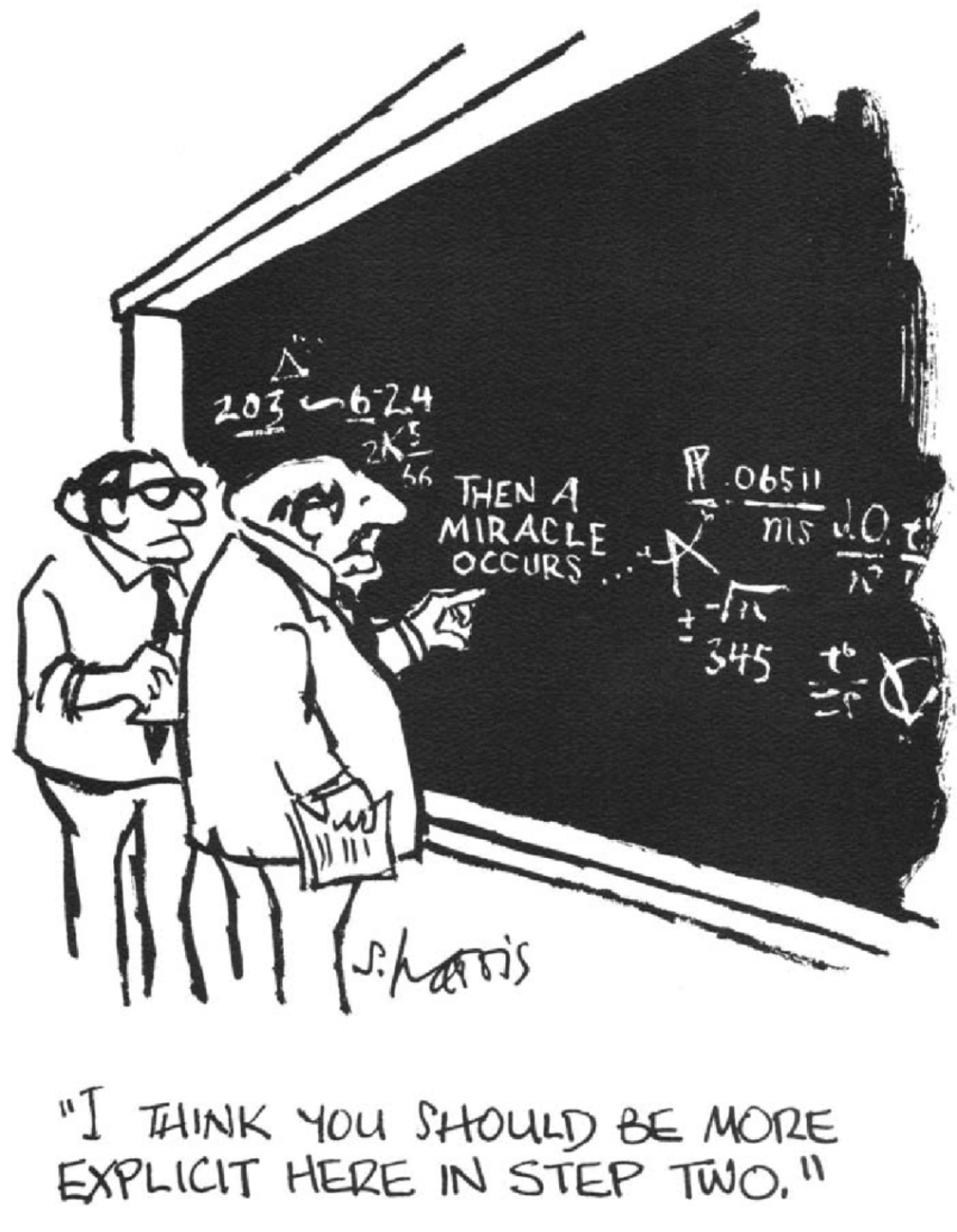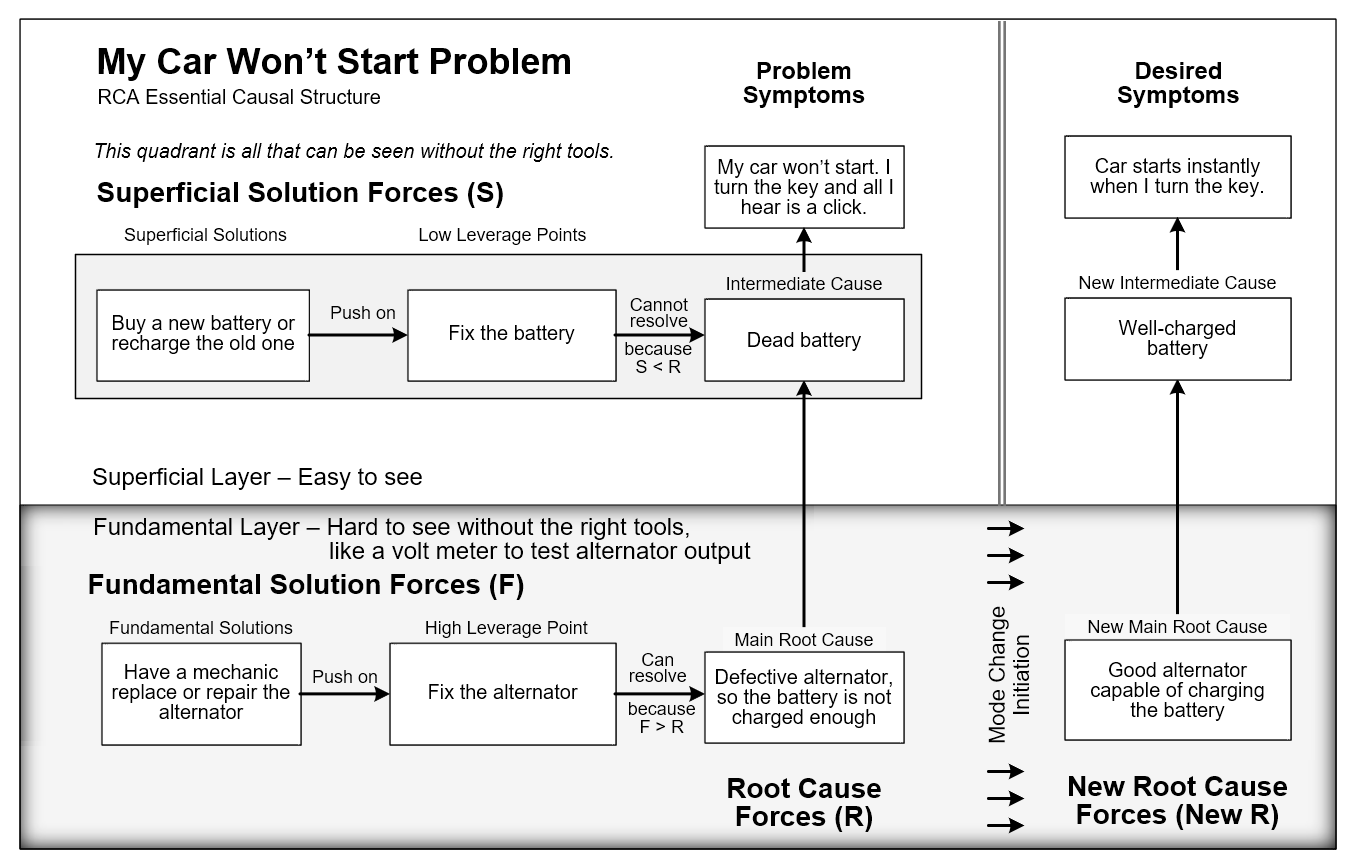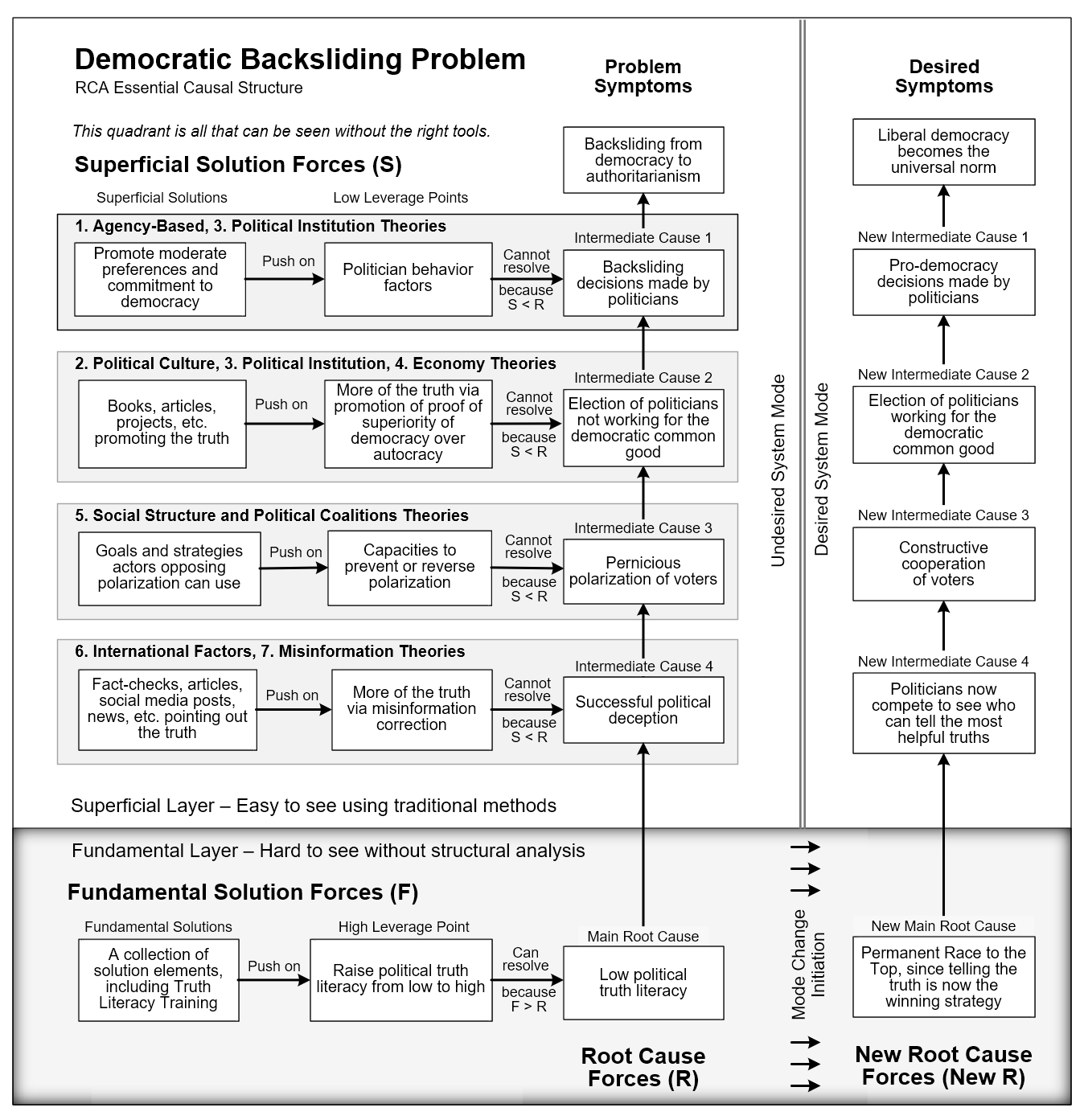Preventing the Death of Democracy:
First a correct diagnosis, then the cure will work
January 1, 2024
Why are popular solutions to the democratic backsliding problem failing? Because of a faulty diagnosis. Accordingly, we show how to perform a correct diagnosis, which opens the door to cures that will work.

As we will show, conventional wisdom has made a rather serious error in step two of the process of root cause analysis, by performing step two intuitively instead of explicitly. Sidney Harris alludes to this type of error in his famous cartoon above. (Copyright by ScienceCartoonsPlus.com, reproduced with permission)
A GLOBAL EPIDEMIC of deadly backsliding from democracy to authoritarianism is underway, with no solution in sight. No nation is immune, not even the birthplace of modern democracy, America, where Donald Trump currently beats Joe Biden in presidential polls and plans to destroy democratic institutions once he enters the White House for the second time. The problem has grown so acute that Freedom House reports that after 17 straight years of democratic decline, 80% of the world’s population lives in non-democracies.
The severity of the problem has attracted countless solution strategies. The most common center on forms of “more of the truth,” such as the Washington Post’s fact checker and Timothy Snyder’s pronouncement that “To stave off authoritarianism in their countries… people must resist the temptation to believe what they’d like to believe and turn instead toward truth.” Protect Democracy’s authoritarian playbook allows journalists to spot the seven basic tactics authoritarians use and report the truth about them. Other solutions focus on building “a broad prodemocratic coalition” to prevent authoritarianism from taking root, as Levitsky and Ziblatt urge in How Democracies Die. Still others attempt to prove democracy is superior to autocracy, like The Democracy Advantage using systematic examination of the data. And so on.
But none of this has worked. Why? For the answer we turn to the planet’s top problem-solving experts: the most successful businesses in the world.
What problem-solving tool do the world’s top three management strategy consultancies (McKinsey, Bain, and BCG) use to solve their client’s toughest causal problems? Root cause analysis in the form of MECE Issue Trees. What tool do 100% of aerospace, motor vehicle, electronics, and pharmaceutical companies in the Fortune 500 and 82% of all companies in the Fortune 100 (source) use for quality control? Root cause analysis in the form of Six Sigma. The pattern is so strong it’s hard to find a large successful company that doesn’t use one or more explicit forms of root causes analysis.
Root cause analysis is the systematic practice of finding, resolving, and preventing recurrence of the root causes of causal problems. A root cause is the deepest cause in a causal chain (or the most basic cause in a feedback loop structure for more complex problems) that can be resolved by changing something in the cause, such as stopping it, increasing it, or fixing it. A causal problem occurs when problem symptoms have causes, such as illness or a car that won’t start. Examples of non-causal problems are information search problems and math problems. Root cause analysis is performed by starting at problem symptoms and asking “Why does this occur?” until the root cause(s) is found.
Root cause analysis is civilization’s core problem solving tool for causal problems. The process has these steps:
The Four Main Steps of Root Cause Analysis
1. Define the problem in terms of its symptoms.
2. Diagnose the problem by finding its root cause(s).
3. Develop solutions for resolving the root cause(s).
4. Implement the solutions.
Every time a doctor treats a patient, they run through these steps. Every time you solve a causal problem, such as why won’t my car start or how can we end this recession, you are using root cause analysis whether you use root cause analysis terminology or not. The key is to get the diagnosis right because everything that follows depends on that.
Now we pose a question that should be of considerable interest to those seeking a tangible way to save democracy. Why are popular solutions to the democratic backsliding problem failing? Given how well defined the problem is and the fact that countless solutions have failed, the answer must be step 2, diagnosis, is flawed. As we explained at the beginning of this article using a cartoon, step two was performed intuitively instead of explicitly.
A flawed diagnosis causes solutions to attempt to solve intermediate (proximate) causes instead of root causes. This won’t work. It would be like diagnosing the reason your car won’t start is a dead battery, so you replace it with a new battery. A week later your battery is dead again, because the root cause was a bad alternator that was unable to charge the battery.
If it's a difficult complex problem, a flawed diagnosis occurs because of the Superficial Solutions Trap. This occurs when due to problem complexity, problem solvers assume an intermediate cause is the root cause. No amount of solution force on an intermediate cause will work, because a root cause emits a much stronger force. Reliably and efficiently solving difficult complex causal problems to a high level of quality requires formal, prolonged application of an appropriate form of root cause analysis. No other method is known.
A picture is worth a thousand words. Instead of a well-crafted cartoon like the one at the beginning of this essay, we use a diagram to illustrate root cause analysis results of the My Car Won’t Start Problem, as shown below. Note how the diagram describes the analysis as clearly and succinctly as a cartoon portrays a complex joke. In both cases the illustration is required.

The form of root cause analysis used is cause-and-effect diagrams organized into superficial and fundamental layers, with the desired system mode change initiated by root cause resolution. Start reading at Problem Symptoms and work down by asking “Why does this occur?” until you arrive at the root cause. Like a good cartoon, the diagram is largely self-explanatory.
What then are the root causes of the democratic backsliding problem? We found four intermediate causes and one main root cause, as shown below. Start reading at Problem Symptoms. Why does backsliding from democracy to authoritarianism occur? Because of backsliding decisions made by politicians. And why does that occur? Because of election of politicians not working for the common good. And so on, until you reach the main root cause.

This is a complex problem, so it should be no surprise the analysis is also complex. But once you understand the diagram the analysis should snap into simplicity, because all that matters is finding the correct root cause. Once we’ve done that, developing a cure for the patient is relatively easy because we have a correct diagnosis.
The numbered phrases (1 to 7) refer to families of theories attempting to explain the problem’s causes. All erroneously assume an intermediate cause is the root cause, which explains why all popular solutions have failed. See this paper in progress for a detailed description of the analysis.
The diagram explains how the main root cause is low political truth literacy, because that allows successful political deception by politicians not working for the common good, like Trump. The high leverage point for resolving the root cause is obvious: raise political truth literacy from low to high. This is a radically different conclusion from popular approaches to the problem because none used an approprioate form of root cause analysis.
But then again, it’s not so radical once the analysis is understood. All the pieces of the puzzle fall into place. The diagram explains why past solutions failed. It also explains why 100% of authoritarians depend on massive amounts of political deception to gain office and stay in office. Examine the evidence. China and Russia are infamous for their dependence on state-sponsered propaganda and control of the media so that their citizens are not exposed to the truth. In the US a well-financed “Right-Wing Propaganda Machine” has dominated political debate for decades. An examination of political behavior in 169 countries in 1,759 elections found four key characteristics of autocracy. All require deception to implement. And then there’s Donald Trump’s 30,573 lies while in office.
Authoritarians work for themselves and the ruling elite, who are a small minority. In a democracy, the main way authoritarians convince the majority to vote for them (and thereby vote against their own best interests) is deception. Force doesn’t work because it’s illegal. Doling out jobs doesn’t work because there are not millions of jobs to give out based on leader loyalty. Bribes don’t work because bribing millions of voters is too expensive. This leaves deception as the main strategy for those working for the uncommon good (a minority) as opposed to the common good (the majority).
Here’s the key conclusion that can prevent the death of democracy:
If average political truth literacy can be raised from low to high, successful political deception is no longer possible.
Once political truth literacy is high, authoritarians will have no way to convince voters to support them instead of politicians working for the common good, and support for authoritatians like Trump would collapse.
But is this hypothesis true? Will pushing on the high leverage point of raise political truth literacy from low to high work? Could it be we are fooling ourselves and that we too have made a faulty diagnosis? The ghost of Richard Feynman whispers in our ear: “The first principle [of science] is that you must not fool yourself, and you are the easiest person to fool.” Science solved this problem with the Scientific Method, which relies on experimentation to test a hypothesis.
To illustrate the solution strategy, six solution elements were designed. The one with the highest probable impact for the least amount of effort appears to be Truth Literacy Training. This trains citizens on how to tell political truth from deception and then use that knowledge to make important political decisions correctly, especially voting.
To experimentally test the hypothesis that the main root cause exists and can be resolved, we performed the Truth Literacy Training study. The results were supportive of the hypothesis and offer tentative proof that the democratic backsliding problem can be solved. Despite the technical nature of the study, we describe it briefly here so that you can see the nitty gritty of the experimental results yourself and draw your own conclusions.
Using an online panel with United States participants, subjects were randomly assigned to treatment groups. Demographics were age range 22 to 51, average age 31, 49% male. Educational levels were 34% high school, 55% college degree, 10% PhD. The trained group (33 subjects) received Truth Literacy Training on how to spot political deception by drilling on a catalogue of common fallacies, how to use of the Personal Truth Test, and how to take appropriate action. The control group (30 subjects) was exposed to a neutral topic.
Results were positive. Average political truth literacy for the control group was very low, 2%, with a 95% confidence range of zero to 10%. This offers initial confirmation the root cause of low political truth literacy exists. Average political truth literacy for the trained group was 67%, a 65-point rise. Training averaged one hour. This suggests that Truth Literacy Training is capable of pushing on the high leverage point of raise political truth literacy from low to high successfully, though replication, larger sample size, and much further research in different political systems is required to fully develop the solution element. The catalogue of common fallacies would be expanded from the seven used in the study to cover the hundreds of common patterns of real-world political deception.
A follow up questionnaire 26 days later showed political truth literacy for the trained group dropped slightly, from 67% to 60%. This rose to 70% with 30 minutes of refresh training, indicating that regular refresh training of some type can work and will be required. Or it may be that like reading and writing literacy, once political truth literacy matures, becomes the reasoning default and is exercised often enough, little decline will occur.
Of interest is the high leverage point has never been pushed on before with focused, large-scale, long-term solution elements. For example:
1. No education system has ever deeply educated students in political truth literacy, right alongside reading, writing, and math literacy.
2. No large news organization has ever made continuing education of the public in political truth literacy part of its mission, via news coverage that includes components of Truth Literacy Training. An example would be a story about how a politician used the cherry-picking fallacy to fool millions of voters.
3. Finally, no government has ever adopted the policy of universal political truth literacy. Yet we have long witnessed the extraordinary gains from universal reading, writing, and math literacy. If the high leverage point is correct, then we can expect the same extraordinary gains from universal political truth literacy.
The goal of this article has been to motivate readers like you to abandon traditional approaches to solving seemingly impossible-to-solve social problems like democratic backsliding and take up root cause analysis.
We view the analysis results presented here as tentative rather than conclusive, and as an example of how root cause analysis can be applied. However, given the confirmatory evidence and experimental results, it appears the analysis has led to a strategically correct diagnosis. If so, then it is only a matter of time and methodical application of the right tools until the patient is cured at last.
For a detailed analysis of the democratic backsliding problem, please see this paper in progress.


























